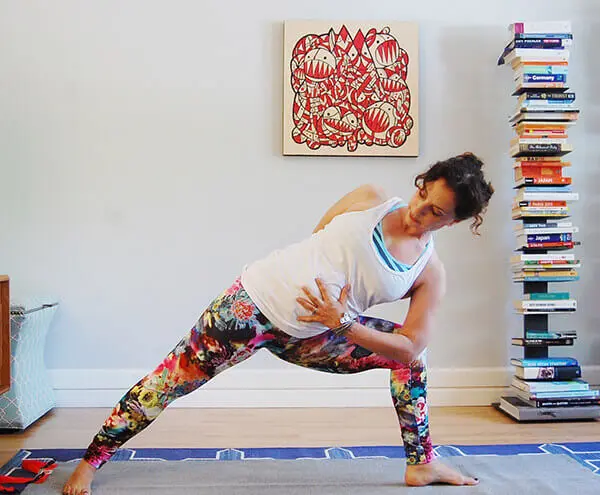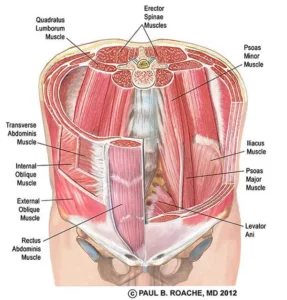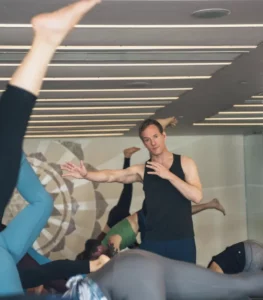Oh, body image. I have been contemplating you so often lately. I think about you as I watch my preschooler climb and hop and run like it’s her j-o-b (because it is) and without inhibitions. I think about you as l watch courageous yoga teachers like Kathryn Budig address body image and internet trolls directly, not only on social media but in this talk she did for Mind Body Green.
And I think about you as I hear Donald Trump spew his misogyny both generally and specifically at powerful, successful women like Megyn Kelly, Rosie O’Donnell, and Heidi Klum.
I think about how convoluted and dysfunctional our culture is about women’s power and women’s bodies and I feel disturbed. I worry about how utterly disempowering and dangerous it is to continue to both unconsciously and openly(!) treat women like chattel. I wonder when my daughter’s joy and purposefulness in her body will start sliding into self-consciousness and shame.
I know that she will look to me as her primary role model. And so, as much as I sometimes want to go hide under a rock when it comes to this very complex issue, I know that I can’t. I have to gather my wits and remember that if I want to see anything positive happen in the world, I have to begin with my own thoughts and behavior.
That’s essentially what Klum did when she responded to Trump’s public barb that she’s “no longer a 10” with this quick video. Not only does it make light of the utter absurdity of his comment, but Klum also clearly shows Trump that she doesn’t care what he thinks about her body and her looks. So what if she’s not a 10 anymore? is what she conveys with a shrug of her shoulders.
#TrumpHasSpoken #sadly #9.99 #NoLongerA10 #IHadAGoodRun #donaldtrump #HeidiTrumpsTrump #BeautyIsInTheEyeOfTheBeheld pic.twitter.com/dwDmEXNKMR
— Heidi Klum (@heidiklum) August 17, 2015
While it might seem easy for a uber successful, ex-super model to make such a statement, it inspired me. It made me think about how I can use tools from yoga to develop a healthier body image and resist the cultural pressure and craziness about women’s bodies.
The Recipe for a Delicious Bod
Here’s what I’ve come up with. It’s a two-part recipe: First, we make an effort to heal our relationships with our bodies by reversing the negative self-talk. Until we do this, we continue to perpetuate the idea that it’s OK to talk about women’s bodies like property. Here’s an example: I caught myself talking about my recent tamoxifen-induced weight gain in front of my daughter recently – I was joking about it, I was laughing about it, but I was also making it a thing. And when I looked down at her I saw that she was watching and listening intently. She was taking in all of that negative self-talk. (Yeah, not a proud moment for me.) If I talk that way about myself, I invite anyone around me to throw their crappy talk in the ring about me or other women. Not good. And a lesson to myself that my own healing process requires long-term effort.
Second, we practice letting go of unhealthy expectations about our bodies–whether they come from other people or from ourselves. (In yoga speak, this is a form of “nonattachment.”)
Letting go of what others think of us is incredibly difficult to execute because we’re culturally attuned to having our ego validated at every turn. We constantly seek praise. And we internalize criticism–whether it’s fair or below to belt–to mean that we’re unworthy. But nonattachment teaches us that if we allow ourselves to consistently internalize praise or shame, we set ourselves up for a lot of disappointment and feelings of personal failure in this life.
One way to practice nonattachment is to be compassionate with ourselves and notice how dynamic and everchanging the body is. We feel different every single day depending on how we slept, what we ate, even how the air feels outside. We feel different from year to year because we grow, our hormones change, we age, we go through stressful times, we go through easy times–and our bodies reflect all of this back to us. Viewed from this perspective, the body is a messenger and one that we should listen to.
Another alternative is to view your body from a spiritual perspective: Your body is not your essence; it’s a vessel for your whole self, including your heart, your spirit, and your mind. It’s not the entirety of your identity.
Pattabhi Jois said, “The body is just a rented house.” Budig puts it another way, calling the body our “meat suit.” They’re both saying the same thing: The body is going to go away. It’s just a buncha flesh and bones. What remains, what’s most important is what’s inside. Your body is a means for you to live your dharma or life’s purpose in this world. And that is undeniably miraculous. So, uh, who cares what someone else thinks of the way it looks?
Can’t I Just Get to My Ideal Weight and Then I’ll Be Happy?
Now, you may be thinking, “Ummmmm, how do I heal my relationship to my body image again? I’m just a little fuzzy on that whole concept. Do I really have to do this or can I just try to get down to my ideal weight and then I’ll be really, truly happy with myself?”
Look, I know how challenging it can be to have a positive body image. But, here’s why it’s important: Feeling negatively about your body is a form of shame. According to sociologist and shame researcher Brene Brown, shame is the feeling that we are inherently flawed and unworthy of love and belonging. Shame is highly correlated with depression, aggression, addiction, suicide, and eating disorders.
Conversely, when you know that you are worthy of love and belonging, you feel powerful. You can go out and fulfill your life’s purpose. So, you gotta do it. You gotta tell yourself, “I am enough. My meat suit is enough!”
If you’re with me on this, here’s my invitation to you. It’s in three parts.
Start With Self Care
Begin with the principal that taking care of your body and maximizing well-being is key. Take stock of the food you eat, the amount of time you set aside for exercise and spiritual practice, the media that you ingest, and the relationships you cultivate. These are all important considerations – and they trump any numbers on the scale. This is the starting place for taking care of your vessel.
Mindfulness Practice: Cultivate the Opposite Thought
Part two comes from Patanjali’s Yoga Sutra, II.33: “When harassed by doubt, cultivate the opposite mental attitude.” (vitarkabadhane pratipakshabhavanam for the Sanskrit junkies in the crowd.)
The idea is to observe your thoughts about your body and, when negative thoughts arise, cultivate the opposite thought.
Try it the next time you practice: Maybe there’s a moment when your body isn’t doing what you want it to, or perhaps you have a “problem area” that just constantly gnaws at your psyche. You know, a part of your body that you think is too long or too short or too squishy or too bony?
These days mine is my tummy. So, as I practice, I observe how often I nitpick my poor, unsuspecting tummy. And then I try to reverse the negative self-talk. Instead of calling it flabby, I remember that it housed a beautiful little human for nearly a year. I put my hand on it. I give it some love and I thank it for doing its job. It doesn’t have to be a grand gesture; just acknowledging the negative thought, turning it around, and moving on is all that’s required.
And I might have to do this over and over and over again throughout my practice. But I make an effort to correct the negative thought pattern and remember that my vessel is a miracle.
Mindfulness Practice 2: Let Go of Praise and Shame
Finally, notice how you respond internally when other people either praise or shame you for your external appearance.
Allow yourself to feel whatever you are feeling. I mean, really hold onto the feeling and let it course through you – whether it’s validation, sadness, fury, whatever. And then: Practice. Letting. It. Go. If you want, you can do this with a visualization – blow it away like a dandelion. Or smack it with a hammer. Sweep it away with a giant broom. If you’re more verbal, process the feelings with a friend or therapist. But then: Consciously allow to there be an endpoint for yourself.
This requires self-discipline, but it’s worth it to put in the effort. As Georg Feuerstein wrote in The Shambala Encyclopedia of Yoga, “Vairagya signifies the mood and practice of renunciation, or the abandonment of passion; sometimes counted as one of the components of self-discipline.”
Remind yourself that your body is a miracle. And it deserves a lifetime of your care and attention. But it is not all of you. You are powerful beyond your external appearance. Tap into that. And go out and live it.



